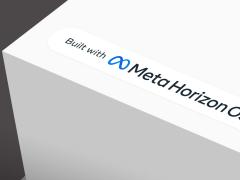Lenovo and Asus are among the companies building headsets that run Horizon software. The move expands Meta’s reach in the AR/VR market, while enabling headset vendors to focus on hardware development rather than software.
Meta will license the software underpinning its Quest headsets to third-party hardware manufacturers in a bid to spur wider adoption of mixed-reality technology.
Access to Horizon OS — the operating system used in Quest devices — should reduce barriers to market for hardware makers seeking to create new products, Meta said. And software developers will benefit from a larger audience for mixed-reality apps that can be sold in Meta’s Horizon app store (formerly Quest Store).
“Developers will have a much larger range of hardware that can run their apps, and more device makers will expand their market to a wider range of users, much like we’ve seen with PCs and smartphones,” Meta said in a blog post Monday.
The push for an open ecosystem offers Meta a chance to build on its early dominance in the AR/VR market, say analysts, while lowering the barrier for entry to hardware makers.
“This is a smart move for Meta to diversify their hardware ecosystem, while also working to make Meta Horizon OS the standard mixed-reality headset OS,” said Will McKeon-White, senior analyst at Forrester.“Before, they were effectively dependent on Oculus sales — this decouples their OS from their headset and hardware efforts.”
What is Horizon OS — and who will use it?
Based on a modified version of Google’s Android operating system, Meta’s Horizon OS is the result of a decade of work to build virtual and mixed reality products, the company said. Meta has spent billions of dollars in recent years to create devices such as the Quest 3 and Quest Pro. This includes adding features such as real-time video pass-through, “inside-out” tracking that tracks a user’s movements and position, and spatial anchors that allow digital objects to be fixed in physical space.
Several companies have already lined up to incorporate Horizon OS into their hardware: Lenovo, Asus, and Microsoft’s Xbox gaming business.
Asus and Xbox will focus on gaming, while Lenovo — which previously partnered with Meta to produce the Oculus Rift S — will develop headsets targeted at “productivity, learning and development,” Meta said. It may take a couple of years before the devices are available, Meta CEO Mark Zuckerberg said in an Instagram video message Monday.
By opening its OS to others in the market, Meta is “taking a page out of the Google playbook,” said Ramon Llamas, research director with IDC’s devices and displays team, referencing Android’s position in the smartphone and smartwatch markets.
“Google put together the platform and a bunch of vendors ran with it,” he said, noting that Google’s own hardware competes with partners such as Samsung and others that rely on Android.
As with Android on smartphones, access to a pre-existing software ecosystem is a big draw for mixed-reality headset vendors, particularly at an early stage of the market when demand remains low.
Creating a mixed-reality headset is a significant engineering challenge for hardware makers, Llamas said, and the need to also build the underlying software compounds the issue. “Especially if you’re a small player, that’s a terrific hurdle to cross,” he said.
Some of those issues are now being removed, however. Headset vendors can now get specialized VR chipsets from Qualcomm, with a software platform available from Meta. “That’s an attractive value proposition — this is going to remove a lot of barriers for a lot of companies,” said Llamas.
A more mature ecosystem could help drive customer adoption. By incorporating Meta’s Horizon OS, hardware vendors could find it easier to convince customers they have the requisite apps and ecosystem to support their product, said Anshel Sag, principal analyst at Moor Insights and Strategy.
Despite the potential benefits, hardware vendors need to consider whether partnering with Meta is the right strategy. “It remains to be seen who else is going to jump on board,” he said. “There’s a lot to like, but do your due diligence and make sure this is a good fit for you.”
Meta is the dominant player in AR/VR market, accounting for over 60% of units sold in Q4 of 2023, according to IDC data. It’s a large chunk of a relatively small market, with IDC forecasting 9.7 million devices will be sold globally this year.
Though demand for mixed-reality devices has not yet taken off, Meta faces competition on several fronts. The launch of Apple’s Vision Pro earlier this year provided a new rival (alongside validation of the device category), though Apple’s costly device is only expected to sell a few hundred thousand units this year.
Google is also expected to provide the operating system for Samsung’s mixed-reality headset that’s due to launch later this year. While Google is the major challenger to Apple’s mobile ecosystem with Android, the extent of its ambitions in the AR/VR market remain aren’t clear at this stage.
Meta, which has made the biggest investment in mixed-reality technologies in recent years, has an early advantage, said Sag, with a relatively strong library of 3D apps compared to Google and Apple; the latter two are effectively starting from scratch with their own software efforts.
The decision to provide access to its OS could provide another advantage going forward. “Meta has the headstart here…, opening their ecosystem and making development easier will be a challenge to Apple and Google and will ultimately benefit everyone, with more competition among ecosystems,” said Sag.
For mixed-reality device customers, increased competition in the market should be good news.
“The real winner in all this is going to be the end user,” said Llamas. “It’s going to be the consumer for now, and it’s going to be the enterprise user shortly thereafter.”





